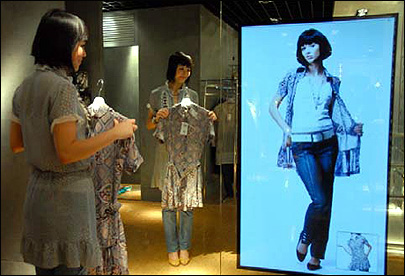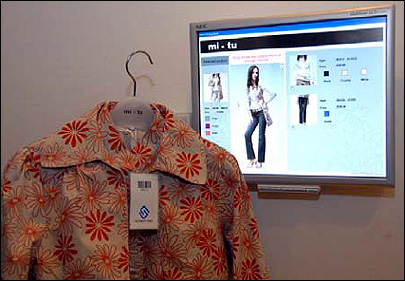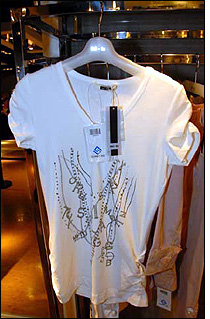Sep 04, 2007Upscale fashion label and retailer Mi-Tu has outfitted two of its Hong Kong shops with RFID-enabled mirrors and electronic displays. The devices enable customers, at a glance, to view and locate a wide selection of in-store inventory while they try on and shop for clothes. The first store was equipped in November 2006, and the second deployment occurred in May of this year.
The interactive shopping system has increased sales in the stores by 30 percent, according to Mi-Tu, which sells Italian designs at 28 stores in China, Hong Kong and Macau and caters to young, high-spending female shoppers. By November, Mi-Tu will install the system in a third Hong Kong store.

Mi-Tu is using Schmidt Electronics' Smart Retail System (SRS), which includes Smart Fitting Rooms featuring mirrors (known as Smart Dressing Mirrors) with EPC Gen 2 RFID antennas and interrogators installed behind them. The fitting rooms also feature LCD displays mounted on the wall, adjacent to the mirrors. The SRS system also comprises an electronic catalog (e-catalogue) application, RFID-enabled VIP customer cards, and a security system that alerts shopkeepers if a tagged garment is removed from the store.
The Smart Dressing Mirror and Smart Fitting Room elements were codeveloped by Schmidt in cooperation with Hong Kong Polytechnic University's Institute of Textiles and Clothing. Mi-Tu first approached the university about a year ago, seeking an RFID-based system that could personalize the shopping experience. The university then asked Schmidt to design a system that could provide additional choices and information to customers, both in the dressing rooms and throughout the store.
Mi-Tu attaches EPC Gen 2 tags, manufactured by Schmidt, on all garments in both stores' inventory. Each tag has a unique ID number associated with the garment's model name and description, including size, color and fabric, in Mi-Tu's Microsoft-based back-end system.
As a customer enters the fitting room and approaches the mirror holding a tagged item, the system captures and transmits the ID number, via an Ethernet connection, to the store's back-end system. The SRS software correlates the tag's number with those of other garments, and images of the corresponding items are then displayed on the nearby LCD. The customer can watch a series of images and text on the screen, which recommends mix-and-match items for the garment in hand.
According to Matthew Man, Schmidt's general manager, the RFID system has increased sales by making more choices available to shoppers as they try on items. Customers often enter the fitting room holding only a single item of clothing, he says, but end up requesting additional items to try on along with that garment, based on options provided via the LCD screen.

The system collects data as to which items have been tried on and which have been sold, enabling Mi-Tu to analyze the success of the products sold in its stores.
Mi-Tu has installed e-catalogues within the store area, which include an RFID interrogator, a PC and an LCD screen. To learn more about a particular piece of clothing, a shopper presents that garment to the reader, which captures its RFID tag number. The PC displays brand information, a garment description, fabric information and pricing on the LCD, and the e-catalogue alerts the shopper if other sizes or colors are available, as well as the specific area of the store in which they are located.
In addition, the RFID tags are designed to help deter shoplifting. All tags are removed at the point of sale for reuse on other items, so if a customer attempts to take an unpurchased item garment outside the store, a reader at the door captures its tag ID number and sends an alert to the sales desk.
With the upcoming third store installation, Mi-Tu plans to implement a VIP system. Participating customers will receive RFID-enabled VIP cards, embedded with Gen 2 RFID chips encoded with customers' unique ID numbers. When a card-carrying customer enters the store, the reader captures her ID number and sends it to the back-end system, where it is associated with that person's purchasing history.
Initially, Man recalls, some customers expressed concern about the dressing room system. "They wanted to know if there were hidden cameras," he says, "and they wondered, 'How do you know what item I have?'" Once they were familiar with the system and understood that it uses RFID technology rather than cameras, he says, "they have adapted very quickly without concerns."

"The customer doesn't want to be hassled by sales staff," Man explains. "They want privacy in their shopping experience. In this way, they can try items on in their own time, at their own pace. It is more comfortable."
For the third installation, Schmidt is developing a new system, called a G-Box. This system could reduce existing costs by almost 50 percent, Man predicts, because the software, antenna and interrogator will all be integrated into a single unit. "They would see their return on investment much more quickly," he states. Thus far, Mi-Tu has paid about US$80,000 per store for the system.
"Our objective is to bring out a more efficient and satisfactory service to our customers," says Katherine Ho, Mi-Tu's managing director. " We will continuously upgrade our system to satisfy each customer's need." She adds, "The system will definitely help drive our sales revenue," by enabling "proactive promotions of additional products."
RFID technology company Paxar (now a division of Avery Dennison) and merchandising solutions provider thebigspace developed a similar system, known as the magicmirror. Announced in 2006, this system allows retail customers to use an RFID-enabled mirror to receive automated customer service while trying on clothing (see Magicmirror Could Assist Retail Customers).


